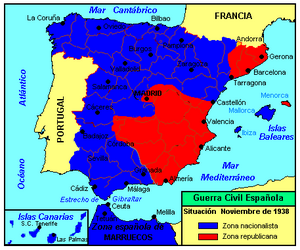Fall of Barcelona
| Catalonia Offensive | |||||||
|---|---|---|---|---|---|---|---|
| Part of the Spanish Civil War | |||||||
 Map of Spain in November 1938, after the end of the Battle of the Ebro and immediately before the start of the Catalonia Offensive. Republican territory is in red, and Nationalist territory is blue. |
|||||||
|
|||||||
| Belligerents | |||||||
|
|
|
||||||
| Commanders and leaders | |||||||
|
|
|
||||||
| Strength | |||||||
| Thomas: 300,000 Beevor: 220,000 Jackson: 90,000 Thomas: 360 artillery pieces Beevor: 250 artillery pieces Thomas: 200 tanks and armoured cars Beevor: 40 tanks and armoured cars Thomas: 80 aircraft Beevor: 106 aircraft |
Jackson: 350,000 Beevor: 340,000 Thomas: 300,000 Beevor: 1,400 artillery pieces Thomas: 565 artillery pieces 300 tanks 500 aircraft |
||||||
| Casualties and losses | |||||||
| ? dead 10,000 wounded 60,000 captured 220,000 disarmed in France |
? dead ? wounded ? captured |
||||||
The Catalonia Offensive was part of the Spanish Civil War. The Nationalist Army started the offensive on December 23, 1938, and rapidly conquered Republican-held Catalonia with Barcelona (the Republic's capital city from October 1937). Barcelona was captured on January 26, 1939. The Republican government headed for the French border. Thousands of people fleeing the Nationalists also crossed the frontier in the following month, to be placed in internment camps. Franco closed the border with France by February 10, 1939.
After its defeat at the Battle of the Ebro the Republican Army was broken and would never recover. The Republicans had lost most of their armament and experienced units. Furthermore, in October 1938 the Republican government agreed to withdraw the volunteers of the International Brigades. On the other hand, the Nationalists received new supplies of ammunition, weapons and aircraft from Germany. Furthermore, after the Munich Agreement, the hope of an intervention of the Western democracies in order to aid the Republic against Germany and Italy vanished.France had closed the frontier again in mid-June 1938 and froze Republican financial assets in French banks.
At the beginning of December, the rebel faction concentrated an Army Group, the Army of the North, of 300,000–340,000 men led by the general Fidel Dávila in order to conquer Catalonia. The Nationalists assembled their best divisions all along the front from the Pyrenees to the Mediterranean. Along the Segre the Nationalists deployed Muñoz Grandes's Army of Urgel, Garcia Valiño's Army of Maestrazgo and Moscardo's Aragon Army; in the confluence of the Segre with the Ebro Gambara's Italian Cuerpo Legionario Italiano of four divisions (55,000 men) and Solchaga's Army Corps of Navarra; and in the Ebro the Yagüe's Moroccan Corps. The Nationalists also had, according to Beevor, 300 tanks, more than 500 aircraft (among them the Me-109e and Heinkel 112 fighters) and 1,400 cannon.
...
Wikipedia
